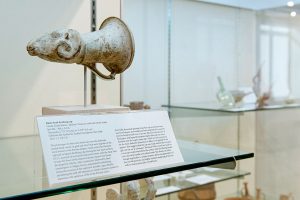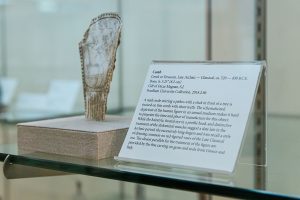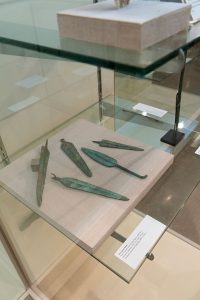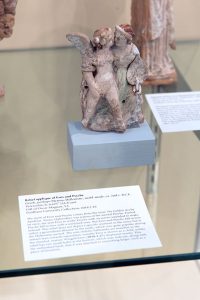The Museum of Greek, Etruscan, and Roman Art will reopen in the Walsh Family Library after a renovation, once again displaying antiquities dating back to the 10th century B.C. On view in its new glass cases will be Greek ceramic jars from 400 B.C.E., Roman coins, amulets and jewelry from the 1st century B.C., and more.

The museum has offered the hands-on experience to Fordham classes over the years, with students curating exhibits on classical objects, including one last year dedicated to ancient glass.
Classes will once again be able to meet directly in the museum, a large conference table surrounded by exhibits.
“The important thing about teaching from the objects is that nothing makes students more excited about the ancient world than being able to handle something that is 2,500 years old,” said Jennifer Udell, Ph.D., the museum’s curator.
The renovation of the museum, which first opened in 2007, has improved its display cases, brightened the space significantly, and made possible the display of objects that had not previously been viewed by the public.

The original collection, which featured more than 260 antiquities dating from the 10th century B.C. through the 3rd century, was a gift from William D. Walsh, FCRH ’51, and his wife Jane. It grew over the years as the museum received several major gifts, including a 2014 gift of nine mosaics from the 5th century. In 2018, the museum received a collection of 118 objects comprised of small terracotta and bronze figurines and Roman glass.
Udell said that the items in the 2018 acquisition were an important addition to the museum’s holdings, but many were kept in storage because the museum lacked space to display them. But in 2021, Udell learned that she’d have a lot more space to spare.
Helping Resolve An Art Trafficking Case
In September 2021, Udell shared in a blog post that the museum had closed its doors on June 1. That day, the Manhattan District Attorney’s office seized 99 objects in the collection as evidence in an ongoing criminal investigation of a trafficker in ancient art.
Three months later, those objects and 61 more from other institutions, tied to Edoardo Almagià, a Rome-based antiquities dealer, were repatriated to the Italian Government.
Rethinking How to Show Objects
For Udell, the loss of the items was an opportunity for reinvention.
“Everybody said ‘Do you still have a museum? And I said, ‘Yes, we just have a different museum, with different types of material. The new install has given me a way to rethink how we show objects.”

Thanks to the generosity of Mark and Esther Villamar, she was able to purchase custom-made display cases that are brighter, more secure, and accessible from the back, for easier access. Carpeting has been replaced with polished concrete floors, and a large conference table has been installed in an alcove.
When it came to organizing the objects, Udell started with a description of Walsh’s original collection.
“Once you start putting objects in a case, then you have to see how things evolve. It’s difficult to plan from the get-go, and say ‘Ok, this is going to go here and that’s gonna go there.’ I kind of let it evolve organically,” she said.
That means pairing for the first time together the ram head drinking cup with an Askos (flask) with Nike figurines and Medusa heads in relief dating back to B.C.E. 300. An Etruscan Amphora (jar with two handles) from circa 650 B.C.E. is now the centerpiece of a case centering on Etruscan burial ceremonies.

In one of the cases, Udell grouped together never before displayed implements and tools, including spear blades, a cosmetic applicator, a neolithic spoon, and a flint hand axe dating back from 300,000 to 150,000 BCE.
Another new display features half a dozen pieces that are in fact forgeries.
“Were they specific forgeries or were they just tourist trinkets that then over time were viewed as deliberate fakes? Who knows?” she said.
“So this is fun to look at with students and to say, ‘Why aren’t they genuine?
This is the Real Thing
Linda LoSchiavo, director of Fordham Libraries, noted that the initial creation of the museum was the first major renovation to the Walsh Library, as the space was originally designed to be a periodical reading room. Many spaces in the building have been updated since then, so it made perfect sense to update this space now.
“This gave us entrée to rethink and reexamine everything that was in there, and go in the direction that it was inevitably destined to go—not just as a place to view beautiful things, but as an arm of teaching and learning,” she said.

“Whether you have a student who’s just inches away from an Etruscan vase as someone is turning it and showing it from every angle, or you have a medieval manuscript placed in front of them and you’re turning the pages, you’re allowing them to interact directly with history,” she said.
“This is the real thing.”
For Udell, the renovation is everything she wanted to create when she first arrived in 2007. The display cases have room for more objects, and Udell has secured loans for objects from the Metropolitan Museum of Art that will arrive in September. She anticipates working with other institutions in the future as well.
“There are lots of exciting collaborative things happening with other New York City institutions, so I’m excited about that,” she said.
“And I’m just excited about being able to unveil this collection in its best aesthetic possibility.”
